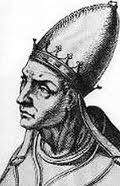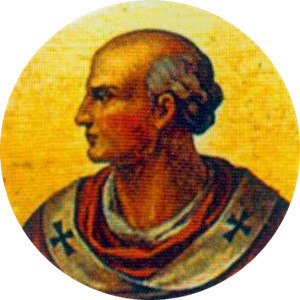Sources
- Gregorovius, Ferdinand. Rome in the Middle Ages Vol. IV. trans. Annie Hamilton. 1905.
Pier Leoni (or Pierleone) (Latin : Petrus Leo or Petrus filius Leonis) (died 2 June 1128) was the son of the Jewish convert Leo de Benedicto and founder of the great and important medieval Roman family of the Pierleoni. He was called the Jewish Crassus by Gregorovius.
Pierleone himself was a consul of the eternal city in the early twelfth century. He was one of the regents of the city itself when Pope Paschal II left in 1108 to deal with raising troops. "Rome remained the pit of daily rebellion," as Gregorovius says.
In 1111, Pierleone negotiated the imperial coronation of the Emperor Henry V.
Ever a faithful ally of the pope, in 1117, he retook Rome for him, but was subsequently holed up in his tower by Ptolemy I of Tusculum.
After the election of Bishop John of Gaeta as Gelasius II on 24 January 1118, the new pope was thrown into prison by Cencio II Frangipane. It was Pierleone, with his son Peter, Peter the prefect of the city, and the papal gonfalonier Stephen the Norman, who restored the pope's freedom.
Pierleone held the Theatre of Marcellus, Tiber Island, and the Castel Sant'Angelo, fortress of the popes. He was the greatest man in Rome in his time, the grandson of a Jew of Trastevere. His large marble sarcophagus is preserved in the Basilica of Saint Paul Outside the Walls. Its inscription reads, "a man without an equal, immeasurably rich in money and children." Of these children, he left several sons: Leo, Peter (later Antipope Anacletus II), Jordan (later Patrician of the Commune of Rome), Roger, and Huguizon. It is said that his daughter married Roger I of Sicily.

Pope Benedict V was the pope and ruler of the Papal States from 22 May to 23 June 964, in opposition to Leo VIII. He was overthrown by Emperor Otto I. His brief pontificate occurred at the end of a period known as the Saeculum obscurum.
Pope Stephen IX was the Bishop of Rome and ruler of the Papal States from 3 August 1057 to his death on 29 March 1058. He was a member of the Ardenne-Verdun family, who ruled the Duchy of Lorraine, and started his ecclesiastical career as a canon in Liège. He was invited to Rome by Pope Leo IX, who made him chancellor in 1051 and one of three legates to Constantinople in 1054. The failure of their negotiations with Patriarch Michael I Cerularius of Constantinople and Archbishop Leo of Ohrid led to the permanent East–West Schism. He continued as chancellor to the next pope, Victor II, and was elected abbot of the Benedictine monastery of Montecassino.
Pope Sergius III was the bishop of Rome and nominal ruler of the Papal States from 29 January 904 to his death. He was pope during a period of violence and disorder in central Italy, when warring aristocratic factions sought to use the material and military resources of the papacy. At the behest of Theophylact I of Tusculum, Sergius seized the papal throne from Antipope Christopher, who in turn had deposed Pope Leo V. Sergius' reign was subsequently marked by Theophylact's influence. As pope, Sergius continued many ecclesiastical controversies of his predecessors, including conflict over Pope Formosus' legacy, annulling all ordinations made by the late pope, and the filioque controversy with eastern patriarchs. His pontificate was similarly marked by temporal conflicts, with Sergius' refusal to crown Berengar I of Italy as Holy Roman Emperor, and his support of Byzantine Emperor Leo VI the Wise's fourth marriage. Sergius also saw the restoration of the Lateran Palace.

Pope Leo VIII was a Roman prelate who claimed the Holy See from 963 until 964 in opposition to John XII and Benedict V and again from 23 June 964 to his death. Today, he is considered by the Catholic Church to have been an antipope during the first period and the legitimate Pope during the second. An appointee of Holy Roman Emperor Otto I, Leo VIII's pontificate occurred after the period known as the saeculum obscurum.
Pope Damasus II was the Bishop of Rome and ruler of the Papal States from 17 July 1048 to his death on 9 August that same year. He was the second of the German pontiffs nominated by Emperor Henry III. A native of Bavaria, he was the third German to become pope and had one of the shortest papal reigns.

Benedict X, born Giovanni, was elected to succeed Pope Stephen IX on 5 April 1058, but was opposed by a rival faction that elected Nicholas II. He fled Rome on 24 January 1059 and is today generally regarded as an antipope.
Pope John XIII was the bishop of Rome and ruler of the Papal States from 1 October 965 to his death. His pontificate was caught up in the continuing conflict between the Holy Roman emperor, Otto I, and the Roman nobility. After long and arduous negotiations, he succeeded in arranging a Byzantine marriage for Otto II, in an effort to legitimize the Ottonian claim to imperial dignity. He also established church hierarchy in Poland and Bohemia.

Pope John XII, born Octavian, was the bishop of Rome and ruler of the Papal States from 16 December 955 to his death in 964. He was related to the counts of Tusculum, a powerful Roman family which had dominated papal politics for over half a century. He became pope in his late teenage years or early twenties. In 960, he clashed with the Lombards to the south. Unable to control Rome easily, he sought help from King Otto I of Germany and crowned him emperor. John XII's pontificate became infamous for the alleged depravity and worldliness with which he conducted his office. He soon fell out with Otto, but died before Otto could succeed in his attempt to depose him.
Honorius II, born Pietro Cadalo, was an antipope from 1061 to 1072. He was born in the County of Verona, and became bishop of Parma in 1045. He died at Parma in 1072.
Victor IV was an antipope for a short time, from March to 29 May 1138.
GiordanoPierleoni was the son of the Consul Pier Leoni and therefore brother of Antipope Anacletus II and leader of the Commune of Rome which the people set up in 1143. According to Gregorovius, he was a “maverick” in the great Pierleoni family, for he continued to oppose the papacy after Anacletus' death, when the rest of his clan had returned to support of Rome.
The family of the Pierleoni, meaning "sons of Peter Leo", was a great Roman patrician clan of the Middle Ages, headquartered in a tower house in the quarter of Trastevere that was home to a larger number of Roman Jews. The heads of the family often bore the title consul Romanorum, or "Consul of the Romans," in the early days.
Leo de Benedicto Christiano, or just Benedictus Christianus, was a Jew of Trastevere in the late eleventh century. He converted to Christianity and was baptised by Pope Leo IX, whence he took his Christian name. He related himself to the ancient patrician families of Rome by the marrying of his daughters to powerful suitors. He himself was extremely rich.
Ptolemy I was the count of Tusculum in the first quarter of the twelfth century. He was a son of Gregory III. Peter Pisanus, in his Vita Paschalis II refers to Ptolemy and the abbot of Farfa as the allies of the emperor in the same way that the Saints Peter and Paul were the allies of the pope.
Ptolemy II was the count of Tusculum and consul of the Romans from 1126 to his death. He was the son and successor of Ptolemy I.
John of Crema was an Italian papal legate and cardinal. He was a close supporter of Pope Callistus II.
Pietro Senex was Cardinal-Bishop of Porto from 1102 until his death. He was born probably in Rome.

The 1118 Papal Election was held to choose the successor for Pope Paschal II, who died in Rome on 21 January 1118, after an 18-year pontificate. Pope Gelasius II was elected as his successor. The election happened during the Investiture Controversy, a conflict between supporters of the Papacy and those of the Holy Roman Emperor. The election was held under the threat of possible violence due to the controversy. The Cardinal electors took refuge in the Benedictine monastery, S. Maria in Pallara, during the election. Within minutes of his election as pope, Gelasius II was attacked and imprisoned by the Frangipani faction, supporters of the Holy Roman Emperor. Gelasius managed to escape, but at the emperor's arrival with his army, he fled Rome and never returned.

The 1099 papal election following the death of Pope Urban II took place on 13 August 1099. Before his death, Urban had designated Cardinal Rainerius da Bieda as his successor. The cardinal-electors, with the consent of the lower Roman clergy, chose Rainerius, who, after a flight and over his considerable objections, accepted and took the name Paschal II. He was consecrated a bishop and crowned pope on the next day.
Petrus Pisanus was a Roman Catholic Cardinal. He began his career in papal service as a scriptor in the chancellery. He was appointed Deacon of San Giorgio in Velabro, and then promoted Cardinal-priest of Santa Susanna. He served briefly as papal legate in Corsica, before becoming a permanent member of the papal court. He participated in the papal elections of 1118, 1124, and 1130. In 1130, he chose to support the Obedience of Anacletus II rather than that of Innocent II. After Anacletus died in 1138, he joined the Obedience of Innocent II, and survived the purge of 1139.